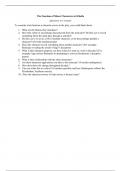The Function of Minor Characters in Othello
Questions to Consider
To consider what function a character serves in the play, you could think about:
1. What are the themes they introduce?
2. How they relate or are perhaps disconnected from the main plot? Do they act to reveal
something about the main plot, through a sub plot?
3. Do they serve to act as a foil of another character, or do they perhaps parallel a
character? (Or both simultaneously)
4. Does this character reveal something about another character? (For example:
Roderigo revealing the extent of Iago’s deception)
5. What is their dramatic purpose, are they echoed or used as a tool in the play? (For
example: Iago echoes Brabantio in attempting to convey Desdemona’s deceptive
nature)
6. What is their relationship with the other characters?
7. Are there numerous approaches you take to the character? (Consider ambiguities)
8. How does their role change throughout the play?
9. Can you relate this to context? (Consider typicality and how Shakespeare reflects the
Elizabethan/ Jacobean society)
10. Does the character convey or help convey a literary trope?
, The Clown
Context:
Clown characters were based upon the real-life career of court jesters, who were employed by nobles and
royalty to entertain them by use of physical and verbal comedy. Shakespeare utilizes these characters of clowns,
or this ‘fool’ trope, throughout his plays. They are perceived to serve the role of comedic relief, however the
jovial Clown in Othello functions beyond this role.
What is the dramatic function of the clown, and how does Shakespeare’s characterisation portray this?
Granville-Barker briefly discusses the role of the Clown as “For relaxation before the tense main business of
the tragedy begins” also stating that “After the prolonged and close-knit tensions some such unqualified
relief as the Clown now brings with his antic chatter will be welcome.” Barker simply justifies the dramatic
role of the Clown as ‘comic relief’. There are elements of his character which function to relieve tensions as he
is introduced following Iago’s soliloquy in which he outlines his plot (“Dull not device by coldness and
delay”-Act 2). With the opening of Act 3, the sinister machinations of Iago are followed by the jovial attitude
exuded by the clown’s interactions which marks a contrast in mood. The Clown has been instructed by Othello
to send away the musicians. I believe*, Shakespeare’s use of the ‘Clown’ is beyond merely ‘comic relief’.
Another more convincing explanation of the Clown’s function is as G. Wilson Knight displays in The
Shakespearian Tempest. He depicts how Shakespeare conceives of peace and agreement in terms of music
played or sung in tune, and of disagreement and conflict in terms of music out of tune. The music offered by
Cassio is rejected through the medium of the Clown whose quibbles centre the theme of cacophony.
The humour of the Clown’s misconstruction of Cassio’s “Dost thou hear, my honest friend?” is significant
when understood within its context. The Clown replies “No, I hear not your honest friend; I hear you”. This
miscomprehension is comical, but that through which Othello is victimised is far from a fact we cant forget, and
thus there is a sense of grimness to the Clown’s jest even while it incites laughter. Shakespeare’s choice of
adjective “honest” is likely not accidental, Othello only hears his “honest friend” not the true Iago.
The Clown’s second appearance in Act 3, Scene 4 he exists beyond ‘comic relief’. Here the Clown in the
company of Desdemona and Emilia, and he performs a Elizabethan pun, the pun on lie. The Clown’s pun on lie
(“I know not where he lodges, and for me to devise a lodging and say lies here, or he lies there, were to lie
mine own throat”) introduces an outbreak of lying among the major characters. Desdemona asks Emilia where
she could’ve lost the handkerchief (“Where should I lose that handkerchief, Emilia?”), for which she feigns
ignorance (“I know not, madam”). Othello enters and falsely displaying a cold to compel Desdemona to
produce the handkerchief (“I have a salt and sorry rheum offends me. Lend me thy handkerchief”).
Desdemona does not have the handkerchief and Othello invents a falsehood about its origin, stating it was
charmed and magical given by an Egyptian to his mother, and depicts it as symbolic of fidelity. In the final
scene, however, the audience learns the truth from Othello-“It was a handkerchief, an antique token my
father gave my mother”. Desdemona finds it difficult to believe and asks “Is’t possible?”, to which Othello
lies “Tis true; there’s magic in the web of it". This in turn forces Desdemona to deny the loss of the
handkerchief “I say, it is not lost”. All this lying occurs most in the main action, which the Clown is but loosely
connected to. He is essentially a choral figure whose pun on lie directs the audience to the significant action
which follows his quibbles. The significance of his quibbles is implied and not immediately recognised as
Desdemona questions, “Can anything be made of this?” To Desdemona the Clown appears to be talking in
riddles unless we understand the significance of his utterances.
The Clown’s appearance is linked to Othello, in his conversation with Desdemona where he says he cannot find
where Cassio lies: “He’s a soldier; and for one to say a soldier lies is stabbing”. This relates to Iago’s
demonic plan in which he convinces Othello that Cassio “Lie with her” (Desdemona). It is Othello’s inability
to question “honest Iago” which ensures tragic fall. The moral chaos which consumes Othello is largely
prompted through lying; the quibble of the Clown on lie serves a symbol of moral uncertainty and foregrounds
the theme of deceit and lying.
key: *my opinion




